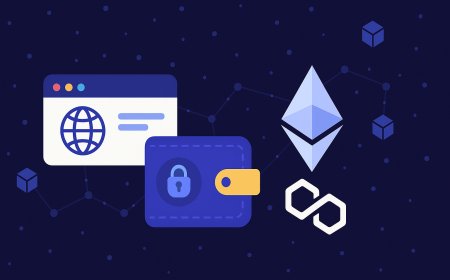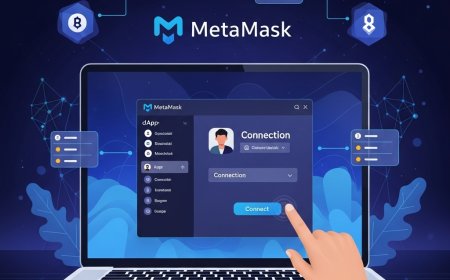What is Play-to-Earn (P2E) Gaming? A Beginner's Guide to Earning Crypto While You Play
Discover Play-to-Earn (P2E) gaming! Learn how blockchain games let you earn crypto & NFTs while you play. Dive into GameFi and the metaverse today.

For years, gamers spent countless hours and often significant money on games, only to have their in-game achievements and digital assets locked within a single platform. But what if your passion for gaming could actually earn you real-world value?
Enter Play-to-Earn (P2E) gaming, often referred to as GameFi (Gaming + Finance). This revolutionary model merges the fun of gaming with the power of blockchain technology, allowing players to earn cryptocurrency and NFTs (Non-Fungible Tokens) through their gameplay, contributions, and ownership.
This guide will break down what P2E gaming is, how it works, and why it's changing the landscape of both gaming and the digital economy. Get ready to turn your playtime into real assets!
What Exactly is Play-to-Earn (P2E) Gaming?
At its core, Play-to-Earn (P2E) gaming is a model where players are rewarded with valuable digital assets for their participation and progress within a game. Unlike traditional games where assets are centrally controlled by the game developer, P2E games leverage blockchain technology to give players true ownership of their in-game items and currencies.
This ownership means:
- Real-World Value: The crypto and NFTs you earn can be traded, sold, or used in other blockchain applications.
- Decentralized Control: Your assets aren't locked away by the game developer; they exist on a public blockchain, verifiable and owned by you.
- Player Empowerment: Players become stakeholders in the game's economy, influencing its direction and benefiting from its success.
How Does Play-to-Earn Work? The Core Mechanics
P2E games operate on a few key principles that differentiate them from traditional gaming:
- Blockchain Integration: The game's economy, including its currency and items, is built on a blockchain (like Ethereum, Polygon, Solana, or BNB Chain). This ensures transparency, immutability, and true ownership.
- In-Game Assets as NFTs: Many valuable in-game items, characters, land plots, and collectibles are represented as NFTs (Non-Fungible Tokens). Since NFTs are unique and verifiable on the blockchain, you truly own them. You can buy, sell, or trade these NFTs on secondary marketplaces.
- Cryptocurrency Rewards: Players earn the game's native cryptocurrency (or sometimes stablecoins) by:
- Completing quests or challenges.
- Winning battles or tournaments.
- Breeding/creating new characters or items.
- Staking their assets.
- Participating in governance.
- Decentralized Autonomous Organizations (DAOs): Some advanced P2E games are moving towards DAO governance, where token holders (players) can vote on the future development and treasury management of the game.
Types of Play-to-Earn Games
The P2E landscape is diverse and rapidly expanding. Here are some popular genres:
- Collectible/Battler Games: Players collect, breed, and battle unique NFT creatures. (e.g., Axie Infinity, Genopets)
- Virtual World/Metaverse Games: Players own virtual land, build structures, and create experiences within shared digital environments. (e.g., Decentraland, The Sandbox)
- Strategy Games: Focus on resource management, empire building, and tactical combat, often with NFT assets. (e.g., Illuvium, Gods Unchained)
- Role-Playing Games (RPGs): Players embark on quests, upgrade characters, and find rare NFT items. (e.g., Big Time)
- Sports/Simulation Games: Games based on sports teams, racing, or other simulations where assets are tokenized. (e.g., Sorare)
Key Concepts in GameFi
To truly understand P2E, you'll encounter some specific terms:
- GameFi: A portmanteau of "Gaming" and "Decentralized Finance" (DeFi), highlighting the financial incentives within blockchain games.
- Blockchain Gaming: Games that integrate blockchain technology for asset ownership, in-game economies, and sometimes decentralized governance.
- NFTs (Non-Fungible Tokens): Unique digital assets (like characters, skins, land) that players own, can trade, and often use within the game.
- Native Tokens: The specific cryptocurrency used within a game's ecosystem (e.g., AXS & SLP for Axie Infinity).
- Staking: Locking up your crypto or NFTs in a smart contract to earn rewards, often used to show commitment to a game.
- Scholarships: In some games (like Axie Infinity), asset owners can lend their NFTs to other players to play and earn, sharing the profits. This lowers the barrier to entry for new players.
Why is P2E Gaming Gaining Traction?
- Monetization for Players: This is the biggest draw. Players can earn an income, ranging from supplemental pocket money to, in some cases, a full-time living.
- True Ownership: Players genuinely own their in-game assets, which can be sold or transferred outside the game.
- Community & Governance: Many P2E games foster strong communities, and some even allow players to vote on game development.
- Accessibility: P2E provides a new way for individuals in developing economies to earn income.
Risks and Considerations in P2E Gaming
While exciting, it's important to approach P2E with caution:
- Volatility: The value of in-game crypto and NFTs can be highly volatile, fluctuating with market trends.
- Upfront Costs: Many P2E games require an initial investment to acquire starting NFTs or tokens.
- Time Commitment: Earning significant rewards often requires considerable time and effort.
- Sustainability: The economic models of some P2E games might not be sustainable in the long term. Do your research!
- Scams & Rug Pulls: Be wary of projects promising unrealistic returns. Always research the development team, community, and whitepaper.
Getting Started with Play-to-Earn Gaming
Ready to dive in? Here's a quick roadmap:
- Set Up a Crypto Wallet: You'll need a Web3 wallet like MetaMask (which you learned about in our previous guide!).
- Research Games: Don't jump into the first game you see. Research the game's mechanics, tokenomics, community, and the development team. Look at reputable sources and reviews.
- Understand the Cost: Be aware of any initial investment required to start playing (e.g., purchasing NFTs, gas fees).
- Connect Your Wallet: Once you choose a game, you'll connect your MetaMask wallet to the game's platform.
- Start Playing & Earning! Follow the game's tutorials and begin your P2E journey.
Conclusion: The Future of Gaming is Earning
Play-to-Earn gaming represents a paradigm shift in how we view digital entertainment. It empowers players, creates new economic opportunities, and builds vibrant, player-owned communities. While the space is still evolving and comes with its own risks, the potential for innovation and financial empowerment is immense.
As you explore this exciting frontier, remember to prioritize research and security. Your journey into GameFi is just beginning!
Ready to find your first P2E game? Check out our [Link to Blockchain Games Sub-category]Top Blockchain Games to Play Now[/Link] or explore the latest updates in [Link to Metaverse News Sub-category]Metaverse News[/Link]!
What's Your Reaction?
 Like
0
Like
0
 Dislike
0
Dislike
0
 Love
0
Love
0
 Funny
0
Funny
0
 Angry
0
Angry
0
 Sad
0
Sad
0
 Wow
0
Wow
0






















